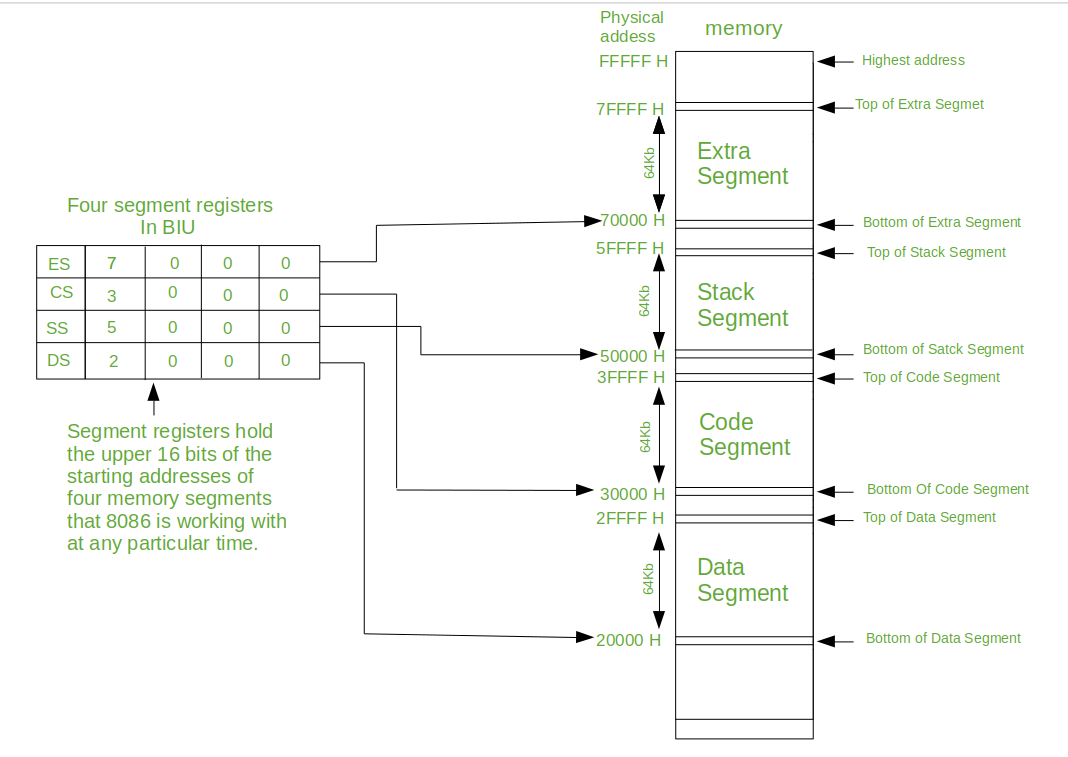Memory Segmentation in 8086 Microprocessor
Last Updated :
18 Oct, 2019
Prerequisite – Segmentation
Segmentation is the process in which the main memory of the computer is logically divided into different segments and each segment has its own base address. It is basically used to enhance the speed of execution of the computer system, so that the processor is able to fetch and execute the data from the memory easily and fast.
Need for Segmentation –
The Bus Interface Unit (BIU) contains four 16 bit special purpose registers (mentioned below) called as Segment Registers.
- Code segment register (CS): is used for addressing memory location in the code segment of the memory, where the executable program is stored.
-
Data segment register (DS): points to the data segment of the memory where the data is stored.
- Extra Segment Register (ES): also refers to a segment in the memory which is another data segment in the memory.
- Stack Segment Register (SS): is used for addressing stack segment of the memory. The stack segment is that segment of memory which is used to store stack data.
The number of address lines in 8086 is 20, 8086 BIU will send 20bit address, so as to access one of the 1MB memory locations. The four segment registers actually contain the upper 16 bits of the starting addresses of the four memory segments of 64 KB each with which the 8086 is working at that instant of time. A segment is a logical unit of memory that may be up to 64 kilobytes long. Each segment is made up of contiguous memory locations. It is an independent, separately addressable unit. Starting address will always be changing. It will not be fixed.
Note that the 8086 does not work the whole 1MB memory at any given time. However, it works only with four 64KB segments within the whole 1MB memory.
Below is the one way of positioning four 64 kilobyte segments within the 1M byte memory space of an 8086.

Types Of Segmentation –
- Overlapping Segment – A segment starts at a particular address and its maximum size can go up to 64kilobytes. But if another segment starts along with this 64kilobytes location of the first segment, then the two are said to be Overlapping Segment.
- Non-Overlapped Segment – A segment starts at a particular address and its maximum size can go up to 64kilobytes. But if another segment starts before this 64kilobytes location of the first segment, then the two segments are said to be Non-Overlapped Segment.
Rules of Segmentation Segmentation process follows some rules as follows:
- The starting address of a segment should be such that it can be evenly divided by 16.
- Minimum size of a segment can be 16 bytes and the maximum can be 64 kB.

Advantages of the Segmentation The main advantages of segmentation are as follows:
- It provides a powerful memory management mechanism.
- Data related or stack related operations can be performed in different segments.
- Code related operation can be done in separate code segments.
- It allows to processes to easily share data.
- It allows to extend the address ability of the processor, i.e. segmentation allows the use of 16 bit registers to give an addressing capability of 1 Megabytes. Without segmentation, it would require 20 bit registers.
- It is possible to enhance the memory size of code data or stack segments beyond 64 KB by allotting more than one segment for each area.
Like Article
Suggest improvement
Share your thoughts in the comments
Please Login to comment...